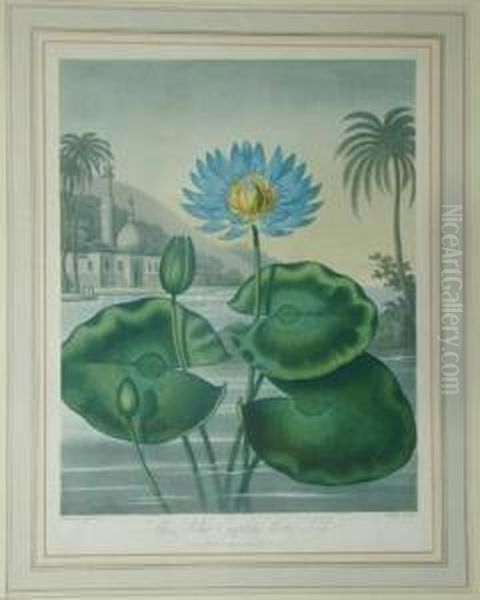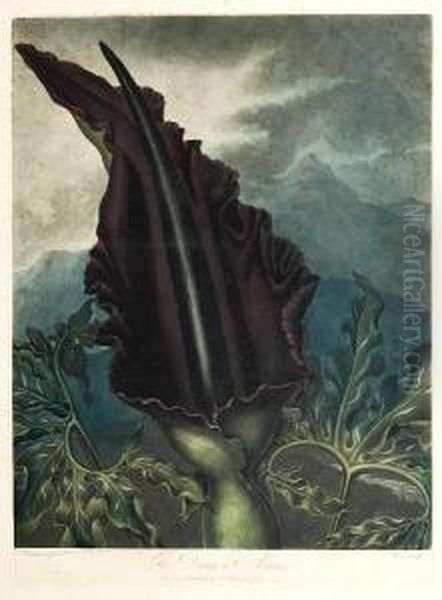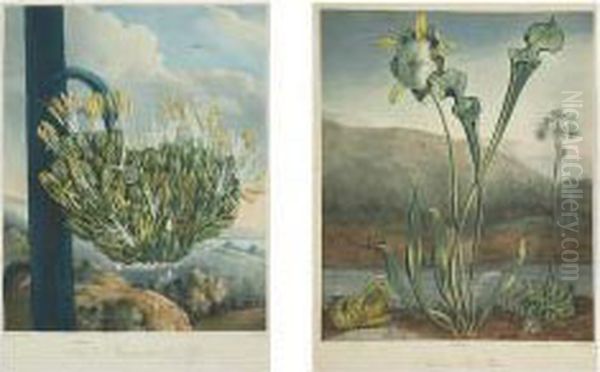Robert John Thornton stands as a unique figure at the crossroads of late 18th and early 19th-century British art, medicine, and botany. While trained as a physician, his enduring legacy is inextricably linked to his ambitious and visually stunning botanical publications, most notably The Temple of Flora. This work, part of a larger project, sought to illustrate the Linnaean system of plant classification with unparalleled artistic grandeur, embodying the spirit of the Romantic era in its dramatic portrayal of the natural world. Thornton's endeavor, though financially ruinous for him, produced some of the most iconic and celebrated botanical plates in history, marking a significant moment in the visual culture of science.
Early Life, Education, and Medical Pursuits
Born in 1768, Robert John Thornton hailed from Yorkshire, England. His academic journey led him to Trinity College, Cambridge, a prestigious institution that would have provided a solid foundation in classical studies and the burgeoning scientific inquiries of the age. Following his university education, Thornton pursued a medical career, undertaking training at the renowned Guy's Hospital in London. This practical medical experience, combined with his academic background, positioned him well to understand the medicinal properties of plants, a field then known as medical botany.
Thornton's passion for botany was not merely a professional adjunct to his medical practice; it was a profound intellectual and aesthetic pursuit. He eventually became a lecturer in medical botany, sharing his knowledge with students and further immersing himself in the study of the plant kingdom. This period was critical in shaping his vision for a grand botanical work that would not only serve a scientific purpose but also captivate the eye and stir the imagination, reflecting the era's growing appreciation for the sublime beauty of nature. His medical understanding likely informed his appreciation for the intricate structures and vital functions of plants, which he later sought to convey through art.
The Grand Vision: A New Illustration of the Sexual System of Linnaeus

Thornton's most ambitious undertaking was A New Illustration of the Sexual System of Carolus von Linnaeus, a monumental work conceived in the late 1790s and published in parts between 1799 and 1807. Carl Linnaeus, the Swedish botanist, physician, and zoologist, had revolutionized the study of the natural world with his system of binomial nomenclature and his classification of plants based on their sexual characteristics (stamens and pistils). Thornton aimed to create a lavish tribute to Linnaeus, one that would visually explicate this system with unprecedented artistic flair.
The New Illustration was planned in three parts. The first part provided a dissertation on the sex of plants according to Linnaeus, and the second offered an exposition of the sexual system itself. However, it is the third part, famously titled Picturesque Botanical Plates of the New Illustration of the Sexual System of Linnaeus, but more commonly known as The Temple of Flora, that secured Thornton's place in art history. This section was intended to be a collection of exquisitely rendered portraits of select flowers, each presented not merely as a scientific specimen but as a dramatic protagonist in its own natural, often romanticized, setting.
The Temple of Flora: An Artistic and Botanical Masterpiece
The Temple of Flora, published between 1799 and 1807, represents the artistic zenith of Thornton's career and a high point of Romantic botanical illustration. It comprised around thirty folio-sized color plates, each depicting a flower or group of flowers with extraordinary attention to detail, vibrant color, and dramatic composition. Thornton employed a team of the finest painters and engravers of his day to realize his vision, sparing no expense in the pursuit of artistic excellence.
The plates are characterized by their large scale and the innovative way they presented their subjects. Unlike the often decontextualized, purely scientific illustrations of earlier botanical artists like Georg Dionysius Ehret or the more delicate, refined studies of his French contemporary Pierre-Joseph Redouté, Thornton's flowers were often set against evocative, sometimes moody and atmospheric, landscape backgrounds. These settings were not always strictly accurate botanically but were designed to enhance the emotional impact and symbolic resonance of the plants, aligning with the Romantic sensibility that valued feeling and imagination alongside empirical observation.
Collaborators and Techniques in The Temple of Flora

To achieve the remarkable quality of The Temple of Flora, Thornton collaborated with a distinguished group of artists and printmakers. Philip Reinagle, a versatile painter known for his animal and landscape subjects, was responsible for many of_the initial paintings, bringing a dynamic and often dramatic quality to the floral subjects. Peter Henderson also contributed significant paintings, noted for their botanical accuracy and graceful execution. Abraham Pether, famed for his moonlit landscapes, lent his distinctive style to some of the more atmospheric and mysterious backgrounds, contributing to the Gothic undertones present in certain plates. Sydenham Edwards, a respected botanical artist in his own right, also produced designs for the series.
The translation of these paintings into prints involved a complex array of techniques, often combined on a single plate to achieve the desired richness of tone and texture. These included aquatint for tonal areas, stipple engraving for delicate modeling, mezzotint for deep, velvety blacks, and line engraving for precise outlines. The plates were then typically hand-colored by skilled artisans, adding a final layer of vibrancy and subtlety. Prominent engravers such as Thomas Burke and James Caldwall were instrumental in this process, their expertise crucial to the project's artistic success. This combination of multiple intaglio processes and hand-finishing made the production incredibly labor-intensive and costly.
Notable Plates and Their Romantic Sensibility
Several plates from The Temple of Flora have become iconic. The Night-Blowing Cereus, for instance, captures the exotic cactus blooming dramatically against a moonlit, ruined church tower, evoking a sense of Gothic mystery and the sublime. The flower itself is rendered with luminous whites and yellows, its ephemeral beauty heightened by the nocturnal setting. Similarly, The Blue Egyptian Water-Lily (Nymphaea caerulea) is presented with majestic grace, its vibrant blue petals contrasting with the dark waters and distant pyramids, hinting at ancient mystique and exoticism.
Other notable plates include The Sensitive Plant, which seems to recoil delicately within a lush, almost fantastical landscape, and The Dragon Arum, with its strange, compelling form set against a stormy, mountainous backdrop, suggesting untamed nature. The American Aloe stands tall and imposing, a testament to nature's grandeur. These images often went beyond mere botanical representation; they were imbued with personality and emotion, reflecting the Romantic era's fascination with the power and diversity of the natural world, and its tendency to see nature as a source of spiritual and aesthetic inspiration. The influence of contemporary Romantic painters like J.M.W. Turner, with his atmospheric landscapes, or even the visionary intensity of William Blake, can be subtly felt in the ambition and expressive power of Thornton's project.
The British Flora and Other Works

Beyond the monumental New Illustration, Thornton also authored The British Flora, published in 1812. This work was a more conventional botanical text, providing systematic descriptions of plants found in Great Britain, illustrated with a large number of smaller, uncolored engravings. While less artistically ambitious than The Temple of Flora, The British Flora demonstrated Thornton's continued commitment to botanical science and education, aiming to provide a comprehensive guide for students and enthusiasts. It followed the Linnaean system and was a significant contribution to the cataloging of native British plant species.
He also published The Philosophy of Medicine: or Medical Extracts on the Nature of Health and Disease (1796), reflecting his medical background, and A new family herbal: or, Popular account of the natures and properties of the various plants used in medicine, diet, and the arts (1810), which combined his botanical and medical interests for a wider audience. These publications underscore his multifaceted career as both a physician and a dedicated botanist.
Professional Life, Ambitions, and Financial Challenges
Thornton's professional life was marked by grand ambitions. He founded the Royal Botanic Society, aiming to promote botanical science and horticulture in Britain. His membership in the Royal Society of Arts further attested to his standing and his contributions to the intersection of art and science. However, his most ambitious project, The Temple of Flora, while an artistic triumph, proved to be a financial catastrophe.
The immense cost of hiring top artists and engravers, coupled with the expensive printing processes and hand-coloring, meant that the subscription price for the work was exceptionally high. Despite its beauty, sales were insufficient to cover the enormous outlay. The Napoleonic Wars also contributed to economic hardship, further impacting the market for such luxury publications. Thornton even resorted to organizing a lottery, with the original paintings and prints as prizes, in a desperate attempt to recoup his losses, but this too failed to alleviate his financial distress. He poured his personal fortune into the project, and its commercial failure ultimately led to his impoverishment.
The Enigmatic Personal Life: John Le Hunt
An intriguing aspect of Thornton's life, as suggested by some historical records, is the possibility that "Robert John Thornton" was an adopted name or persona. Some sources indicate his birth name might have been John Le Hunt and that he was a Catholic. In an era when Catholics in Britain still faced certain civil restrictions and societal prejudices, adopting a different name and persona, perhaps that of a family friend, could have been a means of navigating society more freely or protecting family interests.

If this were the case, it adds another layer to his complex character. This hidden aspect of his identity, combined with his known passion for pursuits like hunting and horse racing, paints a picture of a man of diverse, perhaps even contradictory, interests. His deep religious faith, reportedly a source of strength throughout his financial troubles, and his noted charitable activities, even when facing his own ruin, speak to a man of principle and compassion, regardless of the name he went by. This duality makes him an even more fascinating figure of his time.
Artistic Style: A Fusion of Science and Romanticism
Thornton's artistic style, particularly in The Temple of Flora, is a distinctive fusion of scientific accuracy and Romantic expressiveness. The plants themselves are generally rendered with meticulous attention to botanical detail, ensuring their identifiability and scientific value. Every petal, stamen, and leaf is often carefully delineated, showcasing the intricate structures that Linnaeus had emphasized in his classification system.
However, this scientific realism is consistently elevated by a powerful artistic vision. The use of dramatic lighting, with strong chiaroscuro effects, imbues the plants with a three-dimensional presence and a sense of vitality. Colors are rich and often intense, going beyond mere naturalism to enhance the visual impact. The compositions are dynamic, with plants often depicted from unusual angles or in dramatic poses. Most significantly, the integration of evocative backgrounds – whether stormy skies, moonlit ruins, or exotic landscapes – transforms the botanical subjects into protagonists within a larger, emotionally charged narrative. This approach was a departure from the more restrained, purely illustrative style of many of his predecessors and contemporaries in botanical art, such as the precise work of Franz Bauer or the elegant compositions of Georg Dionysius Ehret.
Contemporaries and the Artistic Milieu
Robert John Thornton operated within a vibrant artistic and scientific milieu in late Georgian and Regency Britain. His collaborators, such as Philip Reinagle, Abraham Pether, and Sydenham Edwards, were established artists. Reinagle, for instance, was an Academician at the Royal Academy, known for his versatility. Pether's moonlit scenes were highly fashionable, aligning with the Gothic revival and the taste for the picturesque.

Beyond his direct collaborators, Thornton's work can be seen in the context of the broader Romantic movement. Painters like J.M.W. Turner and John Constable were revolutionizing landscape painting, emphasizing atmosphere, light, and emotional response to nature. Visionary artists like William Blake were exploring mystical and symbolic themes, often employing innovative printing techniques. In the realm of botanical art, Pierre-Joseph Redouté in France was producing his exquisitely delicate and scientifically precise watercolors of roses and lilies, patronized by Empress Josephine. While Redouté's style was more classical and refined, Thornton's was robustly Romantic and theatrical. Other botanical artists of the period included James Sowerby, whose English Botany was a monumental work of scientific illustration, though generally less artistically dramatic than Thornton's plates. The engraver Francesco Bartolozzi, who popularized stipple engraving in England, also set a high standard for print quality that influenced the era.
Legacy and Art Historical Significance
Despite the financial ruin it brought upon its creator, The Temple of Flora remains one of the most celebrated and audacious achievements in the history of botanical illustration. Its plates are prized by collectors and revered by art historians and botanists alike. Thornton's willingness to blend scientific observation with artistic imagination created a work that transcended the purely utilitarian function of botanical illustration, elevating it to the realm of high art.
His influence can be seen in the way subsequent artists approached the depiction of nature, encouraging a more expressive and less rigidly scientific portrayal. The sheer ambition of the project, and its innovative use of printmaking techniques to achieve rich, painterly effects, set a new benchmark for luxury botanical publications. While the cost and scale of such an undertaking were rarely replicated, the artistic spirit of The Temple of Flora resonated with the Romantic era's deep engagement with the natural world. Artists like John James Audubon, though working with birds rather than plants a few decades later, shared a similar ambition to present natural subjects with life-sized drama and scientific accuracy in his Birds of America.
In art historical terms, Thornton's work is significant for its bold embrace of Romanticism within a scientific discipline. It highlights the porous boundaries between art and science in the late 18th and early 19th centuries and demonstrates how aesthetic trends could powerfully shape the visual representation of scientific knowledge. The dramatic, almost theatrical, presentation of his botanical subjects ensured their enduring appeal and secured Thornton's legacy as a visionary, if tragically flawed, impresario of botanical art.
Conclusion: An Enduring Vision

Robert John Thornton was a man of immense vision, passion, and ambition. His dream of creating the world's most magnificent tribute to Linnaean botany, The Temple of Flora, resulted in a work of breathtaking beauty and profound artistic significance, even as it led to his personal financial downfall. He successfully merged the precision demanded by science with the evocative power of Romantic art, creating images that continue to captivate and inspire. His life, with its blend of medical practice, botanical scholarship, artistic innovation, grand aspirations, and personal hardship, offers a compelling insight into the cultural and intellectual currents of his time. The legacy of Robert John Thornton is not merely in the scientific accuracy of his illustrations, but in their enduring power to convey the awe-inspiring beauty and drama of the plant kingdom, forever enshrined in the magnificent plates of The Temple of Flora.